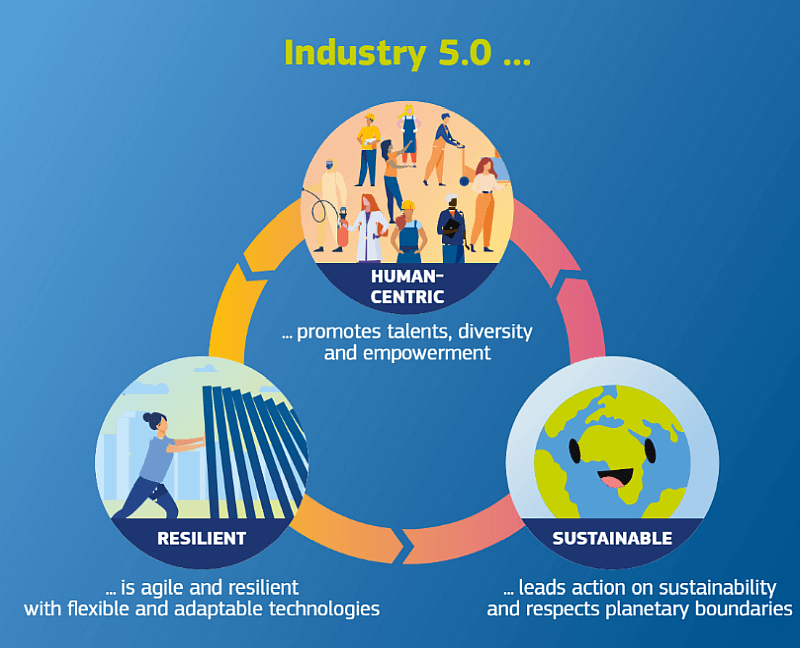Bridging the human-machine gap
Empowering humans, creating resiliency and prioritizing sustainability
Industry 5.0: Empowering humans, creating resiliency and prioritizing sustainability
Note: This is the first in a two-part series on Industry 5.0 and its impact on the manufacturing industry. You can read Part 2 here.
Rapid advancements in technology have resulted in unprecedented gains for industries across the globe, creating a wealth of opportunities for automation and artificial intelligence (AI) to change and enhance the way we – humans – work. But the speed with which new technologies have been, and continue to be, introduced has resulted in unforeseen issues that may have significant impacts on organizations and their employees.
As we move forward, there is a quiet, but growing cry to “right the ship” by bridging the gap between machines, people and the environment in a more thoughtful and future-forward way. Enter Industry 5.0. It’s ok if this is new term to you as this initiative has its roots in the EU and has only recently begun to build awareness in the states.
The current state of industry and manufacturing
Our current iteration of the industrial revolution – Industry 4.0 – came into play in 2011 and is characterized by the use of artificial intelligence, machine-to-machine learning (M2M), the Internet of Things (IoT), cloud computing and robotics in the manufacturing and production processes. This has opened the door for greater efficiencies, cost-savings and competition among both small and large companies.
However, the adoption of Industry 4.0 – and the rush to bring these technological advancements into production – has largely ignored the potential for negative consequences for humans and the environment. Namely, there’s too often a lack of attention to the wellbeing of workers, including the undeserved erosion of trust and value in worker knowledge, a dearth of meaningful regenerative feedback across all aspects of a business and the impact of high energy consumption and resource use on the environment.
Industry 5.0 puts people and the planet at the center
Compared to the length of time of previous industrial revolutions (think decades), the introduction of Industry 5.0 in such a relatively short time after 4.0 may seem odd. But, in reality, it’s keeping pace with the rapid evolution and ever-shifting landscape of modern innovation.
The three main pillars of Industry 5.0 are:
Human-centric design: Moving towards the concept of humans and machines working collaboratively to create more efficiencies across teams and platforms and encourage greater innovation and solutions. Technology should be used to augment human work, allowing workers to tap into their creativity and intuition in ways machines are not able to. According to Clarify, a SaaS data intelligence developer focused on industrial automation, “this approach is also sometimes called ‘society-centric’ as it puts core human needs and interests at the core of the production process and promotes adapting industrial automation technologies to the needs of industry workers. Industry 5.0 recognizes the importance of not just achieving high productivity but also creating safe and inclusive work environments where human health and well-being is a priority.”
Resiliency: Promotes agility and flexibility so companies can more quickly implement restorative feedback and respond to buyer demands. As a recent article in Forbes notes, the resiliency model of Industry 5.0 focuses on “creating organizations that are ‘anti-fragile,”’ meaning that they are able to anticipate, react and learn timely and systematically from any crisis and thereby ensure stable and sustainable performance.”
Sustainability: Development of sustainable production practices that minimize waste, reduce energy consumption and prioritize renewable resources. This includes an emphasis on a circular economy, which the EPA defines as “reducing material use, redesigning materials, products, and services to be less resource intensive, and recapturing ‘waste’ as a resource to manufacture new materials and products.”

To be clear, these are not new or novel ideas, and certainly we have seen many companies and industries prioritize their workers’ health and safety, develop lean and agile work environments and focus on corporate social responsibility or the triple bottom line. But the beauty of Industry 5.0 is that the emphasis on profits and growth is shifted to make room at the top for overall societal well-being. In essence, it’s how technology can be leveraged to empower human work and create more opportunities for companies, workers and our climate to thrive.
Industries are already well poised for Industry 5.0
While it’s only in the early stages of gaining momentum, the virtues – and necessity – of Industry 5.0 are undeniable. In Part 2 of our series, we look at how the technology that has come out of Industry 4.0 has laid the groundwork for the evolution into 5.0, and how companies are already implementing pieces of it.
In the meantime, Matthews Marking Systems has tools and resources in place to support human-machine collaboration. Our MPERIA platform centralizes coding and marking automation across multiple production lines, allowing workers fast access to the necessary data to boost productivity, efficiency and production resiliency.
Want to learn more? Give us a call at 800.775.7775 or email us at [email protected].
